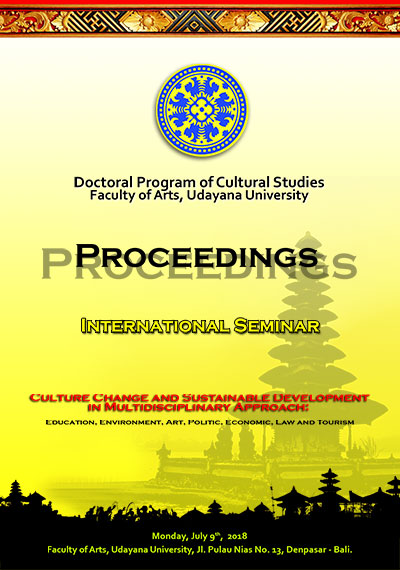APPLIED STUDY OF 'GREEN DESIGN' CONCEPT OF GREEN SCHOOL INTERIOR DESIGN IN SIBANG KAJA VILLAGE, BADUNG
Abstract
Impaired environmental quality; pollution and pollution that cross the health threshold; global warming; damage to marine habitat; new diseases whose power is so fast and the power of killing is high; are some examples of signage the emergence of serious environmental problems and threaten changes in demographic structure of the population around the world. For the international community, this indication of serious environmental problems has sparked a desire to restore themselves to nature, and create a holistic, heal thy environment. This phenomenon eventually triggered the presence of various designs ecology concept 'green design’. In Bali the issue of 'green design' lately is also evolving along with the aware ness of the world community to repay attention to the potential of nature. This is evidenced by the presence of Green School at the Kul Kul Campus in Sibang Kaja Village that carries the conceptt of environmentally sound buildings. Based on the description, this research will examine the applied form of the concept of 'green design' in the interior of the classroom and some supporting spaces. The results will answer whether the concept of 'green design' is applied is completely in line with environmental criteria. The research will be elaborated through descriptive method of analysis. The assessment is based on an analysis of the compatibility between scientific theorists and the observation of several samples presenting each population. The results showed almost all elements of classroom interior in the school building is in line with the concept of environmentally friendly. Starting from the tread processing, space lay out, space forming elements, doors, windows, and facilities is a design that is able to adapt to the potential and carrying capacity of the surrounding nature. Every aesthetic decision taken in the design process is based on moral judgment and ecological ethics.
Downloads
References
Heinz Frick, 1996. Arsitektur dan Lingkungan. KANISIUS, Yogyakarta Heinz Frick, 1998. Dasar-dasar Eko-Arsitektur. KANISIUS, Yogyakarta Heinz Frick, 2007. Hak Konsumen dan Eko Label. KANISIUS, Yogyakarta Otto Soemarwoto, 1987. Ekologi, Lingkungan Hidup dan Pembangunan. Djambatan, Jakarta. Pantas L. Tobing, 1995. Peran Desainer Dalam Mendukung Pengembangan Desain Yang Berwawasan Ekologis, Tesis Program Pascasarjana Jurusan Desain Institut Teknologi Bandung
Soewarno D, 1998. Ekologi Pariwisata. Jurnal Pariwisata Steiepar. Vol 3 Tri Harsono Karyono, 2010. Green Architecture Pengantar Pemahaman Arsitektur Hijau di Indonesia. Rajawalai Pers Jakarta.
Victor Papanek, 1995.Design For The Real World. Thames And Hudson

This work is licensed under a Creative Commons Attribution-NonCommercial-ShareAlike 4.0 International License.





